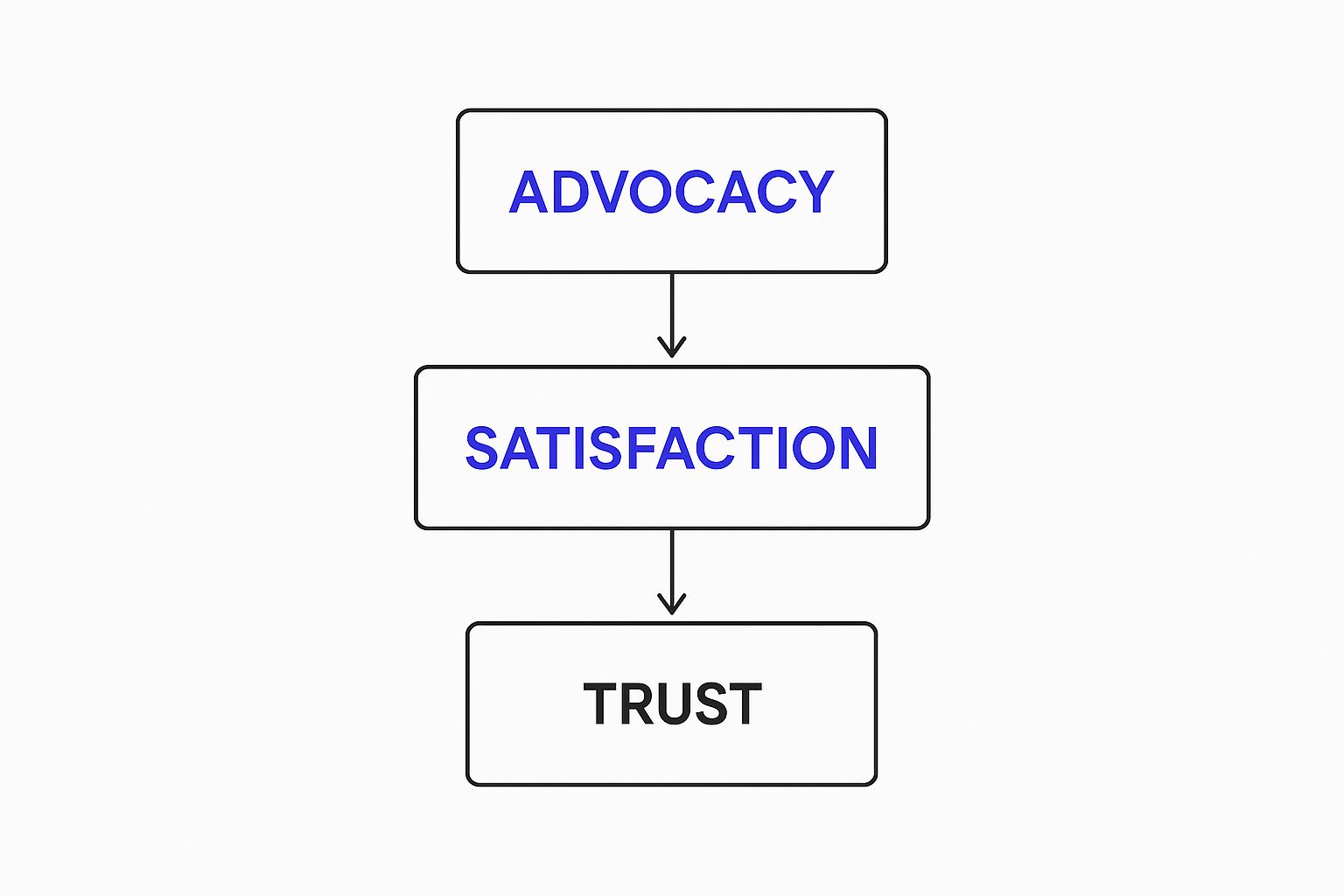What Is Customer Advocacy And How It Grows Your Brand
Learn what is customer advocacy and how to build a program that turns happy customers into your most powerful marketing channel. Get proven strategies now.
Posted by
Think of the last time you bought something based on a friend’s recommendation. Maybe it was a new coffee shop, a can’t-miss TV show, or a piece of software that saved them hours of work. You trusted their opinion far more than any slick ad, right?
That’s customer advocacy in a nutshell. It’s what happens when customers are so happy with your product or service that they go from being a buyer to being a vocal, voluntary cheerleader for your brand.
What Is Customer Advocacy At Its Core?
At its heart, customer advocacy is the organic result of a fantastic customer experience. It’s about turning happy clients into your most authentic and passionate salespeople—the ones who tell their friends, colleagues, and online followers about you without being asked.
This isn't something you can buy with a bigger ad budget. It’s earned. You build it by consistently delivering value and creating genuine relationships. When a customer feels like you truly have their back, their connection to your brand goes way beyond a simple transaction. They become invested.
From Satisfaction to Advocacy
It’s crucial to understand that this is a journey. A satisfied customer is great—they might buy from you again. But an advocate? They’ll go out of their way to convince other people to buy from you, too.
This infographic breaks down how that transformation happens.

As you can see, advocacy is the peak of the relationship, built on a solid foundation of trust and a great experience. And more and more companies are catching on. The 2022 Intuitive State of the Customer Report revealed that 85% of companies now have a customer advocacy program, a huge leap from just 74% in 2020. Clearly, this is no longer a "nice-to-have."
These brand advocates are marketing gold. Their testimonials, reviews, and social media shout-outs create powerful word-of-mouth buzz that new customers trust implicitly. This kind of authentic promotion is a key part of what is social proof in marketing.
To really nail this down, let’s look at the key differences between satisfaction, loyalty, and true advocacy.
Customer Satisfaction vs Loyalty vs Advocacy
Each stage represents a deeper level of connection with your brand. A customer’s mindset and their impact on your business evolve significantly as they move from one stage to the next.
| Stage | Customer Mindset | Business Impact |
|---|---|---|
| Satisfaction | "This product did what I paid for. No complaints." | Transactional relationship, low risk of negative reviews. |
| Loyalty | "I like this brand and will probably buy from them again." | Repeat business, higher lifetime value (LTV). |
| Advocacy | "I love this brand and I want everyone to know about it." | Organic marketing, word-of-mouth referrals, strong social proof. |
Getting a customer to advocacy means they’ve gone from a simple transaction to an emotional investment. That’s the goal.
Customer advocacy is not a campaign; it's a culture. It means putting the customer's best interest at the center of every decision, which in turn creates a self-sustaining engine for organic growth and unwavering loyalty.
Why Advocacy Is Your Strongest Marketing Channel
Let's think about your marketing budget for a second. Most of it probably goes toward traditional advertising—the digital equivalent of constantly buying expensive, high-octane fuel just to keep your growth engine moving.
Customer advocacy, on the other hand, is completely different. It’s like building a powerful, self-sustaining solar-powered engine that generates its own energy over time.

This shift from "buying" attention to "earning" it has some serious financial benefits. When happy customers become your advocates, they essentially become your most trusted marketing team—and you don't even have to pay them. This directly impacts two of the most critical metrics for any business: Customer Acquisition Cost (CAC) and Customer Lifetime Value (CLV).
Lowering Acquisition Costs Through Trust
Every time an advocate refers a friend or leaves a glowing review, they’re handing you a warm lead on a silver platter. These referrals come with built-in trust, which makes them far more likely to convert than someone who just stumbled across one of your ads.
This kind of word-of-mouth marketing is a game-changer for your CAC. Instead of burning cash on ads and hoping you hit the right audience, your advocates are directly connecting you with highly qualified people who already have a positive impression of your brand.
An advocate’s recommendation cuts through all the noise. It’s an authentic endorsement that money can't buy, and it’s the exact social proof modern consumers look for before they pull out their wallets.
Increasing Lifetime Value Organically
Advocates don't just bring in new customers; they're also your most loyal ones. They stick around longer, are more open to buying new products you launch, and consistently spend more over their lifetime. That loyalty creates a stable, predictable revenue stream that strengthens your entire business.
It all feeds into a powerful growth loop:
- Exceptional Experience: It starts with you. You deliver a product and service that genuinely wows your customers.
- Advocacy: Delighted customers voluntarily talk you up through reviews, referrals, and user-generated content (UGC).
- New Customers: All that authentic social proof attracts new, high-trust customers at a much lower cost.
- Increased Loyalty: The positive feedback loop reinforces the value for your existing customers, making them even more loyal.
The financial impact is real. Data shows that even a 12% increase in advocacy can lead to a 2% jump in revenue growth, and advocates are 50% more likely to influence someone else's buying decision. These aren't just vanity metrics; they show a direct line between nurturing customer relationships and building a sustainably profitable business. You can dig into more of this data on how advocacy fuels business growth over at fullview.io.
Ultimately, investing in customer advocacy isn't just a "nice-to-have" strategy. It's a smart business decision that builds a more profitable and resilient brand. It turns your marketing from a cost center into a self-perpetuating cycle of growth, all driven by your happiest customers.
How to Find and Nurture Your Future Brand Champions
Here’s a secret: your most powerful brand champions are probably already your customers. The trick isn't to go hunting for new influencers, but to spot and cultivate the superfans hiding in plain sight. This means you have to stop looking at just transactional data—who spends the most—and start paying attention to how people actually feel and act.
Think of it like a talent scout. A great scout doesn't just draft the biggest, strongest players. They look for heart, hustle, and an infectious love for the game. That’s what you’re looking for, too: customers who are genuinely, deeply enthusiastic about what you do.
Identifying High-Potential Advocates
Finding these future champions means looking for clues beneath the surface. You need to analyze the data that screams high engagement and genuine satisfaction. If you know what to look for, these customers leave a trail of breadcrumbs.
Here are the key signals you should be watching for:
- High Net Promoter Score (NPS): Anyone giving you a 9 or 10 is basically raising their hand and saying, "I'm ready!" They've already told you they're happy enough to recommend you.
- Positive Support Interactions: Keep an eye out for customers who leave glowing feedback after a support ticket gets resolved. It’s a huge sign that they feel heard and valued.
- High Product Engagement: Who are your power users? Pinpoint the people who log in all the time, explore your most advanced features, and spend real time with your product.
- Social Media Mentions: Monitor your social channels for people who voluntarily tag your brand, share their great experiences, or even jump in to defend you in online conversations.
These aren't just purchases; these are signs of a real connection. These customers are already acting like advocates. You just need to give them a nudge.
Nurturing Advocates Without Bribes
Once you've identified these high-potential fans, the goal is to build a real relationship—not just toss a reward their way. The best way to nurture an advocate is to make them feel like a valued insider, not a paid spokesperson. This all starts with nailing the foundational customer retention strategies that build that initial loyalty.
Your focus should always be on providing value and recognition that deepens their connection to your brand.
An advocate wants to feel like a partner in your brand's journey. Recognition, access, and a sense of community are often far more powerful incentives than a simple discount or gift card.
Instead of just throwing money at it, try these relationship-first approaches:
- Offer Exclusive Access: Invite them to beta test new features or join a customer advisory council. This gesture shows you trust their opinion and value their expertise more than anyone else's.
- Create a VIP Community: Build a private space—like a dedicated Slack channel or an exclusive forum—where your top customers can connect with each other and your team directly.
- Provide Genuine Recognition: Feature their success stories in a case study. Spotlight their business on your social media. Send a personal, handwritten thank-you note from the CEO. Small acts of recognition go a long way.
- Amplify Their Voice: Encourage them to share their experiences and create their own content. If you're looking for inspiration, learning how top brands are crushing it with UGC campaigns can give you incredible ideas for empowering your advocates to become creators.
By focusing on building authentic relationships, you turn satisfied customers into a powerful, volunteer marketing army. And that's how you drive organic growth built on real trust and genuine enthusiasm.
Proven Strategies to Build a Thriving Advocacy Program
That raw, organic enthusiasm your customers have? That's gold. But to really make it work for you, you need a plan to channel it. It’s all about building a system that doesn’t just spot your biggest fans but actually gives them the tools to share their stories and drive real growth. Think of it as building a bridge between your happiest customers and your future ones.
The first step is to get official about how you recognize and reward people for shouting you out. A solid referral program is usually the best place to start. The trick is to offer incentives that actually feel worth it—whether that's a discount, a cash kickback, or early access to new features. Whatever you choose, make the whole process dead simple for both the person referring and the new customer signing up.
Beyond just referrals, your program needs to make it incredibly easy for advocates to share their stories. If they have to jump through hoops to leave a testimonial or participate in a case study, they just won't do it. The less friction, the more authentic, high-quality content you’ll get.

Activate Your Advocates on Social Media
Social media is where customer advocacy really comes alive. It's where a real person's recommendation cuts through all the noise from polished corporate ads. Your job is to encourage and amplify all that awesome user-generated content (UGC) where your fans are sharing their genuine experiences with their own circles.
Leaning into effective user generated content strategies can give your program a massive boost. This could be as simple as running a hashtag campaign, featuring customer photos on your official pages, or launching a contest that gets people to submit creative content. When advocates see their posts celebrated by the brand, it makes them feel valued and inspires others to join in.
Just remember, this has to be a two-way conversation. Being responsive is critical. In fact, when brands reply quickly to customers on social media, advocacy can jump by up to 25%. And in the B2B space, where a staggering 75% of buyers use social media to research purchases, that kind of active engagement is non-negotiable for building trust.
Build a Vibrant Advocate Community
A truly great program goes beyond one-off interactions. You want to create a space where your advocates can connect with each other. Building an exclusive online community—maybe a private forum, a dedicated Slack channel, or a Facebook group—gives your champions a real sense of belonging and inside-scoop status.
This community quickly becomes a hub for:
- Peer-to-peer support: Advocates start answering each other's questions, sharing tips, and swapping best practices.
- Direct feedback: You get a straight line to your most passionate users for product ideas and honest opinions.
- Deeper connection: It solidifies their identity as valued insiders who are part of your brand's journey.
The best advocacy programs aren't just transactional. They build a genuine, give-and-take relationship. They make advocates feel seen, heard, and appreciated, which is what makes a program not just scalable, but authentic and sustainable for the long haul.
When you structure your efforts around clear rewards, easy content collection, social media activation, and a strong community, you build a powerful engine for growth. You're transforming random praise into a consistent, measurable marketing force powered by the people who believe in you most.
Alright, let's move past the theory. What does real, powerful customer advocacy actually look like out in the wild?
The brands we all know and love didn't just get lucky. They intentionally built cultures and systems that turned happy customers into their most passionate salespeople. By looking at how they did it, we can pull out some real lessons for any business.
It Starts With an Obsession-Worthy Product
Think about Apple. When was the last time they explicitly asked you to refer a friend? Probably never.
Instead, they focus on one thing: creating a product and an ecosystem that just works. That seamless experience does all the heavy lifting. It creates a tribe of evangelists who feel a deep, personal connection to the brand.
These advocates don't just use Apple products; they see them as part of their identity. They’ll jump into online forums to defend the brand, create "how-to" videos on their own time, and push their friends and family to switch over with genuine passion. Apple's playbook proves a simple truth: the best advocacy starts with a product so good people can't shut up about it.
Building an Empire on Community and Content
While Apple lets the product do the talking, other brands have built empires by putting their community front and center. Take Slack, for instance. Their explosive growth wasn't fueled by Super Bowl ads; it was driven by their earliest power users.
Slack didn't just treat these users like customers. They treated them like co-creators. They built dedicated communities where these champions could swap tips, give direct feedback to the dev team, and connect with each other. This made them feel like insiders—valued partners on a mission. And that feeling motivated them to spread the word inside their own companies, leading to the massive, bottom-up adoption that made Slack famous.
Then you have a brand like Glossier, which basically built its entire marketing department out of its customers. From day one, they encouraged people to share raw, unedited photos of themselves using the products.
By plastering its social media and product pages with real customers, Glossier sent a clear message: "You are our models." This wasn't just a clever way to get an endless supply of authentic content. It created an inclusive community where customers felt seen, celebrated, and part of something bigger.
Each of these brands took a different road, but they all ended up in the same place. They understood that real advocacy isn't about points or discounts. It's about creating an incredible experience, making people feel like they belong, and giving them a reason to share their story.
Whether it’s through a perfect product, a thriving community, or by celebrating your users' content, the lesson is the same: make your customers the heroes. The rest will follow.
How To Measure The Success Of Your Advocacy Efforts
Let's be real: if you can't measure it, you can't improve it. To really get a handle on how well your advocacy program is doing, you have to look past the vanity metrics. Likes and shares are nice, but they don't tell the whole story. You need to track the key performance indicators (KPIs) that actually connect to business growth.
Think of your program as an engine. The right KPIs are the gauges on the dashboard—they tell you how fast you're going, how efficiently you're running, and how much power you're actually generating for the company. Without them, you're just driving blind.
The trick is to start by focusing on metrics that show tangible value. This approach not only helps you tweak your strategy for better results but also makes it a heck of a lot easier to prove the program's ROI to your boss.

Key Advocacy KPIs To Track
To get a clear picture of your program’s health, you need a balanced scorecard. You should be measuring everything from how well your referrals are working to how much great content your advocates are creating.
Here are the essential KPIs you should have on your radar:
- Referral Conversion Rate: This is the big one. What percentage of leads from your advocates actually become paying customers? This tells you if your referral engine is truly effective.
- Volume of User-Generated Content (UGC): How many high-quality reviews, testimonials, and social posts are your advocates creating? This stuff is pure marketing gold.
- Customer-Sourced Leads: Keep a close eye on the number of new leads that came directly from an advocate's activity. This proves their direct influence on your pipeline.
- Advocacy's Impact on Sales Cycle: Do leads from advocates close faster than leads from other channels? A shorter sales cycle is a huge win, making your whole sales process more efficient.
Introducing The Earned Growth Rate
If you want a powerful, C-suite-ready metric, look no further than the Earned Growth Rate. It's gaining a ton of traction, and for good reason. It measures the revenue growth that comes from your existing customers and their referrals. This gives you a clear, undeniable link between happy customers and a healthy bottom line.
The Earned Growth Rate cuts through the noise. It isolates growth that you didn't have to pay for, showing the true financial power of organic word-of-mouth and genuine customer advocacy.
Ultimately, tracking these KPIs using your CRM, analytics tools, and a dedicated advocacy platform like EndorseFlow is what separates a good program from a great one. And don't forget that advocacy is built on a foundation of happiness; check out these ways to measure customer satisfaction to make sure your base is strong. This data-driven approach lets you make smarter decisions and prove just how much value your program is bringing to the table.
Got Questions About Customer Advocacy? Let's Clear Things Up.
Getting into the world of customer advocacy can bring up a few questions. It’s a powerful strategy, but it’s not always straightforward. Let's tackle some of the most common ones so you can get started with confidence.
Customer Advocacy vs. Influencer Marketing: What’s the Real Difference?
This one comes up a lot. The simplest way to think about it is earned trust versus paid reach.
Customer advocacy is what happens when a genuinely happy customer decides to tell people about you. They aren't getting a check for it. It's pure, organic word-of-mouth. On the other hand, influencer marketing is when you pay someone to promote your product to their audience. It's a transaction. Both can work, but advocacy often hits differently because it comes from a place of authentic satisfaction.
How Long Until I Actually See Results?
Building a real advocacy program is a marathon, not a sprint. You're building relationships, and that takes time.
You might see some quick wins, like a few glowing reviews popping up within weeks. But to build a solid, active community of advocates who consistently champion your brand? You’re probably looking at 6-12 months of dedicated effort. The good news is that the results stack up over time, creating a powerful, long-term growth engine for your business.
The best advocacy programs aren't built overnight. They grow from genuine relationships nurtured over time. Keep delivering value, recognize your champions, and the results will follow.
Can a Small Business Really Pull This Off?
Absolutely. In fact, small businesses often have a serious advantage here.
Why? Because they can build much deeper, more personal connections with their customers. You don't need a massive budget. It can be as simple as personally thanking your best customers, asking them for referrals, or offering small, unexpected perks. When it comes to advocacy, authenticity will always beat a big budget.
Ready to turn your happy customers into your most powerful marketing team? EndorseFlow gives you an all-in-one platform to effortlessly collect authentic video testimonials and put your social proof to work. Start your free trial today and see the difference.